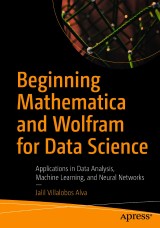Details

Beginning Mathematica and Wolfram for Data Science
Applications in Data Analysis, Machine Learning, and Neural Networks|
56,99 € |
|
| Verlag: | Apress |
| Format: | |
| Veröffentl.: | 01.02.2021 |
| ISBN/EAN: | 9781484265949 |
| Sprache: | englisch |
Dieses eBook enthält ein Wasserzeichen.
Beschreibungen
<p>Enhance your data science programming and analysis with the Wolfram programming language and Mathematica, an applied mathematical tools suite. The book will introduce you to the Wolfram programming language and its syntax, as well as the structure of Mathematica and its advantages and disadvantages.</p><p>You’ll see how to use the Wolfram language for data science from a theoretical and practical perspective. Learning this language makes your data science code better because it is very intuitive and comes with pre-existing functions that can provide a welcoming experience for those who use other programming languages. </p><p>You’ll cover how to use Mathematica where data management and mathematical computations are needed. Along the way you’ll appreciate how Mathematica provides a complete integrated platform: it has a mixed syntax as a result of its symbolic and numerical calculations allowing it to carry out various processes without superfluous lines of code. You’ll learn to use its notebooks as a standard format, which also serves to create detailed reports of the processes carried out. </p><p><b>What You Will Learn</b></p><ul> <li>Use Mathematica to explore data and describe the concepts using Wolfram language commands</li> <li>Create datasets, work with data frames, and create tables</li> <li>Import, export, analyze, and visualize data</li> <li>Work with the Wolfram data repository </li> <li>Build reports on the analysis</li> <li>Use Mathematica for machine learning, with different algorithms, including linear, multiple, and logistic regression; decision trees; and data clustering</li> </ul><p><b>Who This Book Is For</b></p><p> Data scientists new to using Wolfram and Mathematica as a language/tool to program in. Programmers should have some prior programming experience, but can be new to the Wolfram language.<br></p>
<div>1. Introduction to Mathematica.- 2. Data Manipulation.- 3. Working with Data and Datasets.- 4. Import and Export.- 5. Data Visualization.- 6. Statistical Data Analysis.- 7. Data Exploration.- 8. Machine Learning with the Wolfram Language.- 9. Neural Networks with the Wolfram Language.- 10. Neural Network Framework.</div>
<div><b>Jalil Villalobos Alva</b> is a Wolfram language programmer and Mathematica user. He graduated with a degree in engineering physics from the Universidad Iberoamericana in Mexico City. His research background comprises quantum physics, bionformatics, proteomics, and protein design. His academic interests cover the topics of quantum technology, bioinformatics, machine learning, stochastic processes, and space engineering. During his idle hours he likes to play soccer, swim, and listen to music.</div>
<p>Enhance your data science programming and analysis with the Wolfram programming language and Mathematica, an applied mathematical tools suite. The book will introduce you to the Wolfram programming language and its syntax, as well as the structure of Mathematica and its advantages and disadvantages.</p><p>You’ll see how to use the Wolfram language for data science from a theoretical and practical perspective. Learning this language makes your data science code better because it is very intuitive and comes with pre-existing functions that can provide a welcoming experience for those who use other programming languages. </p><p>You’ll cover how to use Mathematica where data management and mathematical computations are needed. Along the way you’ll appreciate how Mathematica provides a complete integrated platform: it has a mixed syntax as a result of its symbolic and numerical calculations allowing it to carry out various processes without superfluous lines of code. You’ll learn to use its notebooks as a standard format, which also serves to create detailed reports of the processes carried out. </p><p>You will:</p><li>Use Mathematica to explore data and describe the concepts using Wolfram language commands</li><li>Create datasets, work with data frames, and create tables</li><li>Import, export, analyze, and visualize data</li><li>Work with the Wolfram data repository</li><li>Build reports on the analysis</li><li>Use Mathematica for machine learning, with different algorithms, including linear, multiple, and logistic regression; decision trees; and data clustering</li>
The first introduction to data science using Mathematica and Wolfram Covers very popular in-demand topics such as machine learning and neural networks Includes freely available source code
Diese Produkte könnten Sie auch interessieren:

Agile Development with ICONIX Process
von: Don Rosenberg, Mark Collins-Cope, Matt Stephens
Preis: 56,99 €
-
-
© 2024 media control GmbH
Alle Preise enthalten die gesetzliche Mehrwertsteuer. - AGB
- Impressum
- Datenschutzerklärung
- Kontakt
- FAQ
- Mein Konto
- Home
- Erweiterte Suche
- Widerrufsrecht
- Reader-Software
- Desktop-Ansicht
- Gutschein-Code einlösen

